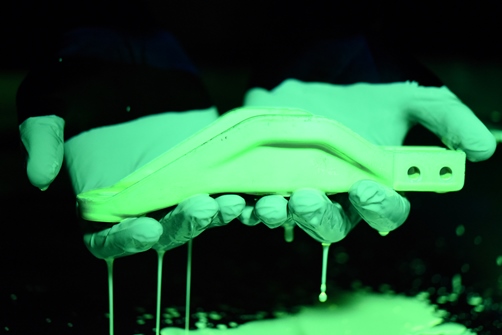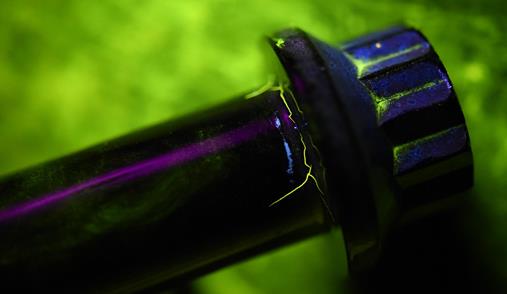Airmen with the 19th Maintenance Squadron (MXS) at the Little Rock Air Force Base in Arkansas are now using nondestructive inspection (NDI) techniques involving black lights to better identify potential cracks in a variety of U.S. aircraft parts.
“We specialize in preventative maintenance,” says U.S. Air Force Staff Sgt. Derik Shannon, an NDI craftsman at the 19th MXS shop. “We use noninvasive ways to inspect aircraft for defects.”
With chemical tanks, conveyer belts, and intricate machines lining the shop's walls, Airmen are progressively using more noninvasive routes—such as the evaluation of aircraft parts underneath ultraviolet (UV) light—to identify potential issues with cracks and corrosion.
Specifically, airmen at the base are now utilizing five methods to detect part discrepancies: magnetic particle, fluorescent penetrant, x-ray, ultrasonic, and eddy current. Each method uses a distinct technique to safeguard the structural integrity of the group’s aircraft.
Fluorescent Liquids, UV Lighting

Two procedures at the base’s NDI shop use magnetic particle oil and fluorescent penetrant. In these procedures, parts are dipped into fluorescent liquids and studied under UV lighting to illuminate small structural flaws.
The liquid penetrant seeps into tiny openings in the aircraft parts under inspection, causing them to become fluorescent under black lighting. This, in turn, makes it easier to detect cracks and corrosion.

In these procedures, the aircraft parts are first run through multiple chemical baths with substances such as magnetic particle oil. From there, the lights in the room are turned off as one UV light shines a spectrum of colors that can be viewed by the NDI technician. Shades of purple, blue, and neon green light illuminate a component’s cracks when placed under the black light.
When a crack is identified, it is documented, marked, and returned to the original shop for further repair.

X-ray and ultrasonic are two other testing methods used at the shop that enable workers to inspect the structural integrity of parts without disassembling it completely.
Eddy Current Most Commonly Used
The most commonly used method, however, is eddy current. This method consists of infusing electricity into an object and creating an opposing magnetic field. Interruptions found within the field are identified as cracks and marked.
The NDI team is capable of performing these inspections both in their shop and also in remote locations away from the shop, such as on the tarmac, according to base officials.
“We [recently] inspected the entire exterior of a C-130J for hail damage,” Shannon says. “Using an eddy current probe, we combed over it in what was expected to be a 48-hour inspection that we finished in eight hours.”
In all, the Little Rock NDI shop inspects ~3,000 parts annually, 19th MXS officials say, with parts studied down to an aircraft's smallest bolt.
“We do the small stuff to keep the big aircraft flying, making sure every little piece is intact,” says Airman 1st Class James Schwein, an NDI journeyman with the 19th MXS.
Source: 19th Airlift Wing, littlerock.af.mil.